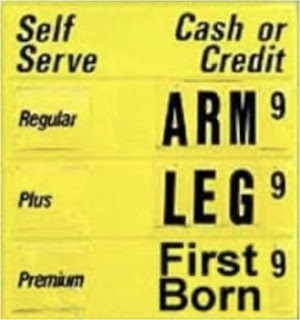I wrote a column on May 24, 2008, entitled “Stop Complaining about Gas Prices”. As you know, here we go again…soaring gas prices but for some different reasons. The good news is all vehicles’ gas mileage has improved considerably in the last 14 years, and we have a lot more hybrid vehicles, and even a few all-electric. I’ve made a few changes and updated my first column, but it’s still essentially the same advice.
“God grant me the serenity to accept the things I cannot change, courage to change the things I can, and the wisdom to know the difference”. Whether you think our gas prices are soaring because of a conspiracy of the giant oil companies, speculators on Wall Street, OPEC, the war in Ukraine, President Biden, ex-President Trump, or Vladimir Putin (or all the above), there’s not much you can do about it. I thought it might be useful to suggest some things you can do about lowering your total cost of fuel even if you can’t lower oil and gas prices.
- Burn the lowest grade octane fuel in your car without causing a ping or knock. Even if your car’s owner’s manual recommends high test, there’s a good chance you can drop down one or two grades of octane and your engine will run just fine. Today’s engines are so sophisticated that they can automatically alter the way the engine runs to accommodate different octane fuels. There are lots of factors that affect how your car runs on a particular grade of fuel like ambient temperature and ethanol content. You can even experiment with mixing octanes. Buying a lower octane will save you several cents per gallon.
- Keep your tires inflated about halfway between the recommended inflations by the auto manufacturer and the tire manufacturer. The higher number is stamped on the tire by the tire manufacturer and the lower inflation number can be found in your owner’s manual. The auto manufacturer number is very low, because he wants the car to drive smoothly. The auto manufacturer doesn’t worry about tire life because that’s guaranteed by the tire manufacturer. The tire manufacturer’s number is the maximum inflation you should use.
- There’s a great app you can download, www.GasBuddy.com, that will show you the gas stations nearest your zip code with the lowest gas prices. I just checked my Gas Buddy app for my zip code, 33403, for price of mid-premium gasoline. The lowest price was $3.99, and the highest was $5.42. Buying the lower one would save me $8.60 on 20 gallons of gas!
- Drive slower! Some of you may remember how some states lowered speed limits on highways during an earlier energy crunch. You burn far less gas at 50 mph than 75 or 80. I’ll be the first one to admit that driving slower than the traffic flow can be “hazardous to your health”. Be sure to drive in the right lane and drive near the the speed limit.
- Learn how to drive your car for maximum fuel efficiency. It’s not uncommon for one of my customers to complain that they aren’t getting the gas mileage on their model Toyota that the EPA sticker on their car when they bought it says they should. We always check the mileage by having one of our technicians drive the car and measure the mileage. Usually, the technician gets as good or better gas mileage than the EPA estimate. This is simply because he understands how to drive a car for maximum fuel efficiency. One of my technicians, Rick Kearney, tells our customers that the best thing they can do to improve their gas mileage is to “reach down and take the brick out of their shoe”. 😊 He also suggests that you imagine there is an “egg” between your foot and the gas pedal. Anticipate stops and curves so that you don’t have to brake, but just take your foot off the gas pedal. For longer stops like waiting for a bridge to go up or down, or a train going by, turn off your engine.
- Check your wheel alignment and rotate and balance your tires every time you bring your car in for your car’s factory recommended service. Also, check your tire inflation that mention in #2.
- Many cars today have an “Eco Mode” alert light, typically green, on the dash which tells you that your speed is maximizing your fuel economy. Watch this and you can save lots of fuel.
- Lastly, if you own a hybrid vehicle (lucky you), you need to drive it differently than you would an all-gas-powered car. A hybrid gets better fuel economy in city driving than highway. This is because your hybrid automatically recharges its battery whenever you take your foot off the gas and decelerate. Stop and go driving causes poor gas mileage in a totally gas powered car, but increases fuel economy in a hybrid. When driving your hybrid on long highway trips, try to maintain a steady speed around 55 or 60 mph. Driving 70 or 80 will cost your fuel economy.
If you follow all these tips, don’t be surprised if you find yourself spending no more on fuel than you did before gas prices skyrocketed. You’ll also be driving a lot safer and feel less aggravation.


No comments:
Post a Comment
Earl Stewart On Cars welcomes comments from everyone - supporters and critics alike. We'd like to keep the language and content "PG Rated" so please refrain from vulgarity and inappropriate language. We will delete any comment that violates these guidelines. Oh yeah - one more thing: no commercials! Other than that, comment-away!